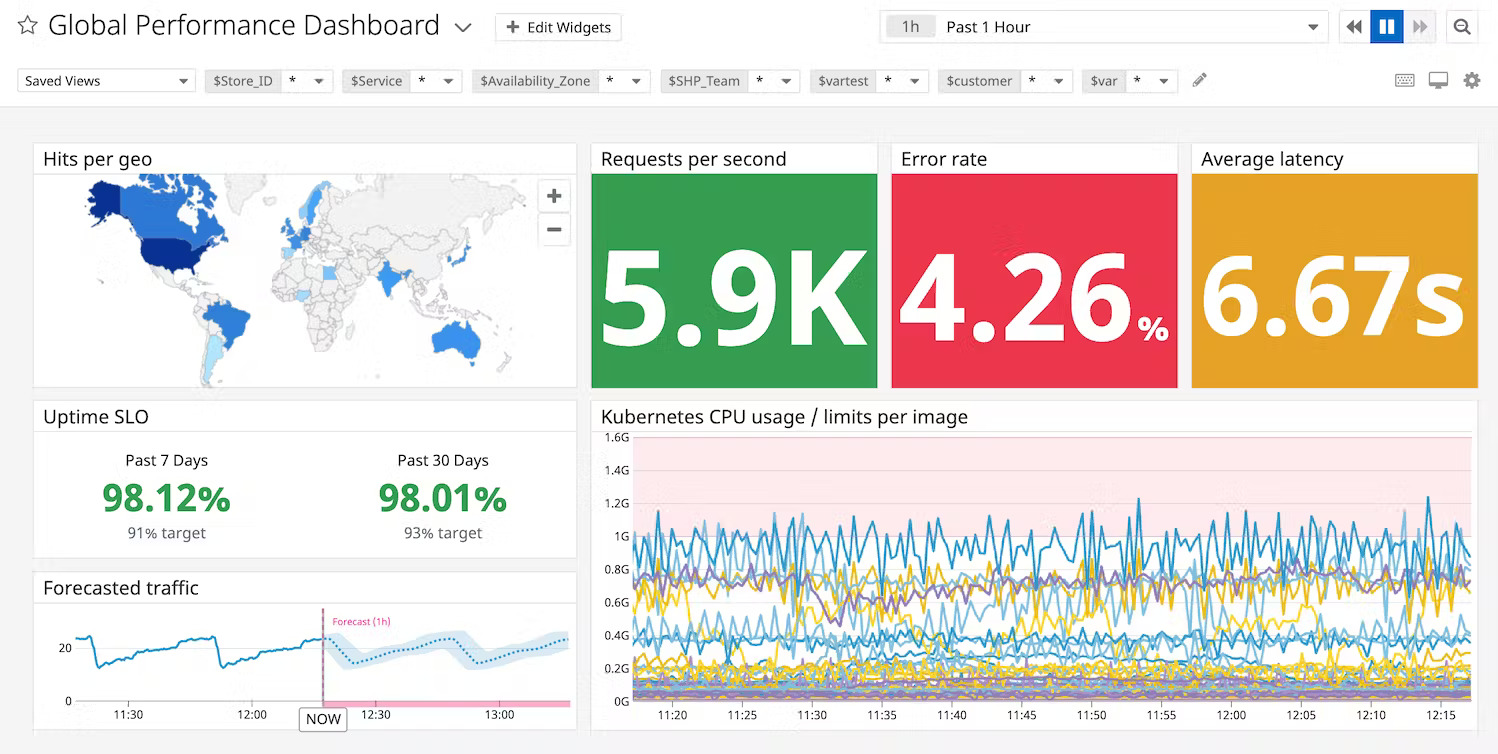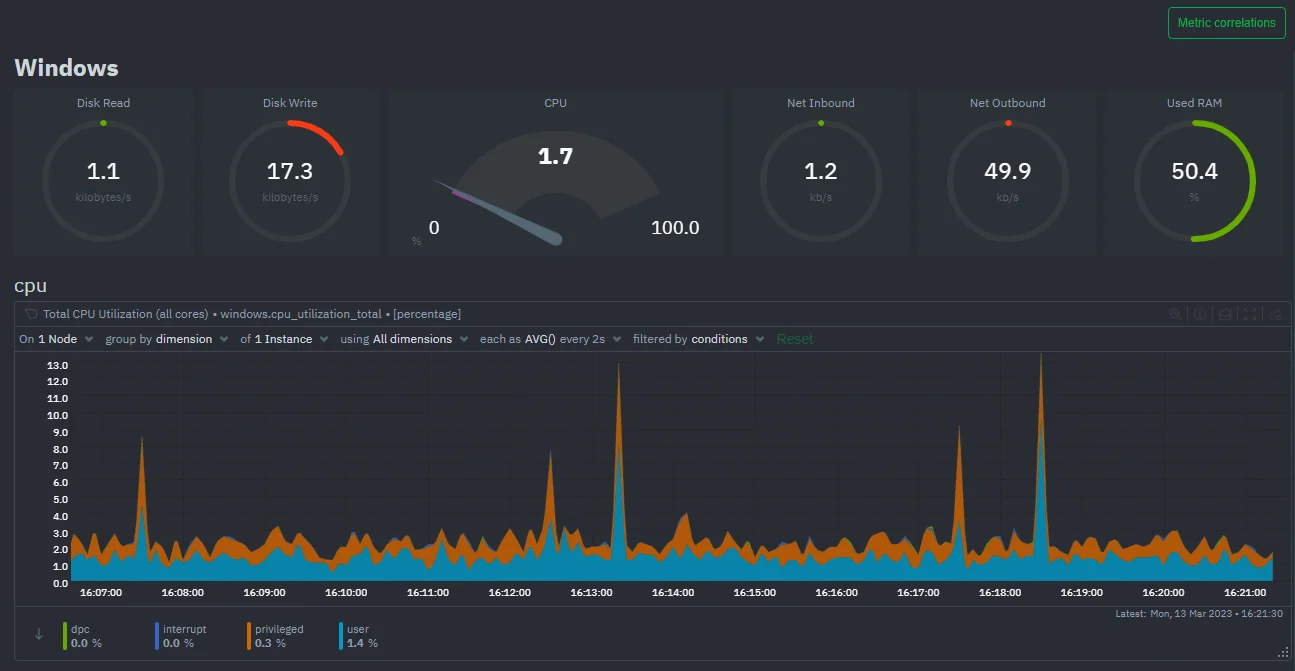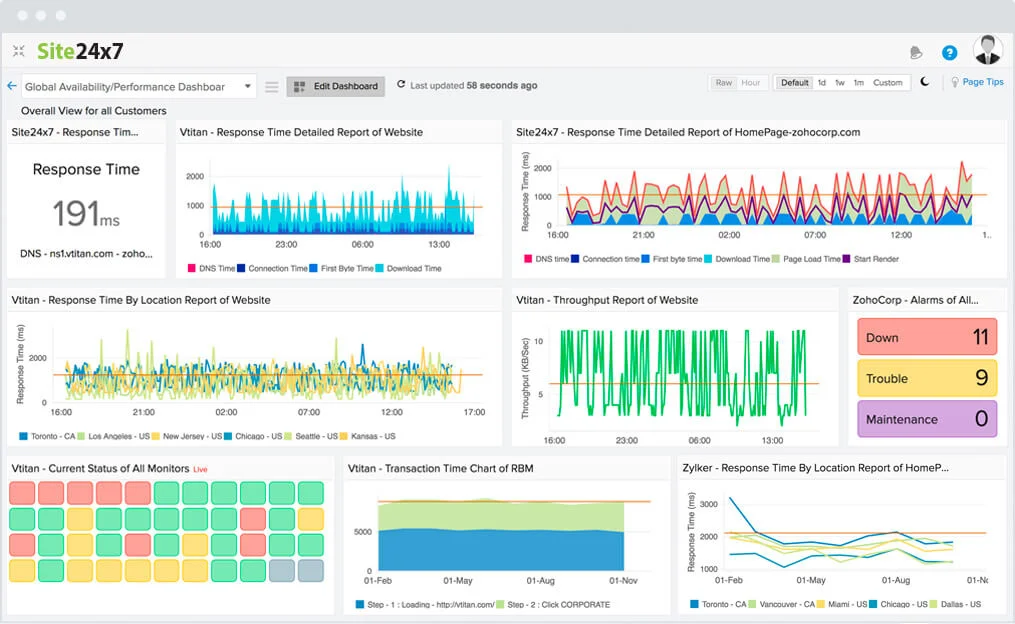
Top 11 Splunk Alternative in 2024
Are you looking for the best Splunk Alternative for 2024?
Splunk is a powerhouse platform that transforms machine data, the lifeblood of modern IT systems, into actionable insights. It empowers users across diverse roles, from security analysts to business leaders, to make informed decisions and optimize operations.
Splunk acts as a powerful unified platform for security and observability. It doesn’t just analyze data and logs, it empowers you to monitor and visualize it in real time, helping you identify patterns, troubleshoot issues, and optimize your entire IT environment.
Think of Splunk as a search engine for your machine data. Using a web-based interface, you can easily dive into the wealth of information collected from servers, applications, networks, and security systems. With its intuitive search language and visualization tools, you can unearth hidden trends, pinpoint anomalies, and gain a holistic understanding of your IT landscape.
While Splunk is a powerful platform, it may not be the perfect fit for everyone. Here’s a breakdown of its potential drawbacks and considerations for alternative solutions:
Drawbacks of Splunk:
- Complexity: Setting up and configuring Splunk can be challenging, especially for those without technical expertise.
- Cost: Splunk’s pricing can be high, particularly for smaller businesses with limited data volumes.
- Performance: Processing large datasets can impact performance, requiring significant server resources.
- User Interface: Some users find the interface dated and less intuitive compared to newer alternatives.
Considering Alternatives:
If these drawbacks resonate with your needs, exploring Splunk alternatives might be wise. Here are some key factors to consider when evaluating alternative solutions:
- Ease of Use: Opt for platforms with intuitive interfaces and minimal setup complexity.
- Cost-Effectiveness: Choose solutions that align with your budget and data volume.
- Scalability: Ensure the platform can adapt to your anticipated data growth and needs.
- Features: Select a solution offering the functionalities you require, like monitoring, observability, and log management
By understanding your specific needs and limitations, you can confidently choose a Splunk alternative that provides the perfect balance of features, ease of use, and affordability for your organization.
Splunk Alternative in 2024
UptimeMonster
Reliable website and server monitoring service from the cloud to monitor your web availability, performance, and security. The tool will give you a 24/7 website monitoring service that will Monitor the availability of your website, APIs, and business-critical web transactions with powerful synthetic monitoring and testing tools.
It collects, correlates, and monitors servers alongside data from the rest of your stack. UptimeMonster server monitoring allows you to visualize, analyze, and track down different query metrics happening on your server so that you can prevent them before anything goes wrong.
Monitor your network performance like IP, DNS, Service port, Application, and others using the check monitoring tools. It will enable you to understand the network behavior and track NetFlow.
UptimeMonster check monitoring service will give you full control over your network. The check monitoring types are as follows
- TCP (Transmission Control Protocol)
- ICMP PING (Internet Control Message Protocol)
- IP Blacklist
- UDP (User Datagram Protocol)
- DNS (Domain Name Server)
- Application Monitoring
With a status page, you can share your monitoring activities and incidents with customers. You can easily make our status page public or private. You can highly customize your status page and share it with your customers to reduce the number of customer support tickets.
Using the status page you can easily gain trust from your customers. The alert notification easily notifies your customers about any incidents so that they can take necessary steps to prevent the issue. So that they will always be prepared and stay tuned.
Create and customize intricate policies for the escalation of incidents by taking into consideration various factors, including the passage of time, the availability of your team, and the source or origin of the incident.
The primary advantage, however, lies in integrated incident management and alerting. This is particularly advantageous for DevOps teams aiming to streamline their stack and potentially handle everything from a unified platform, eliminating the necessity for additional platforms.
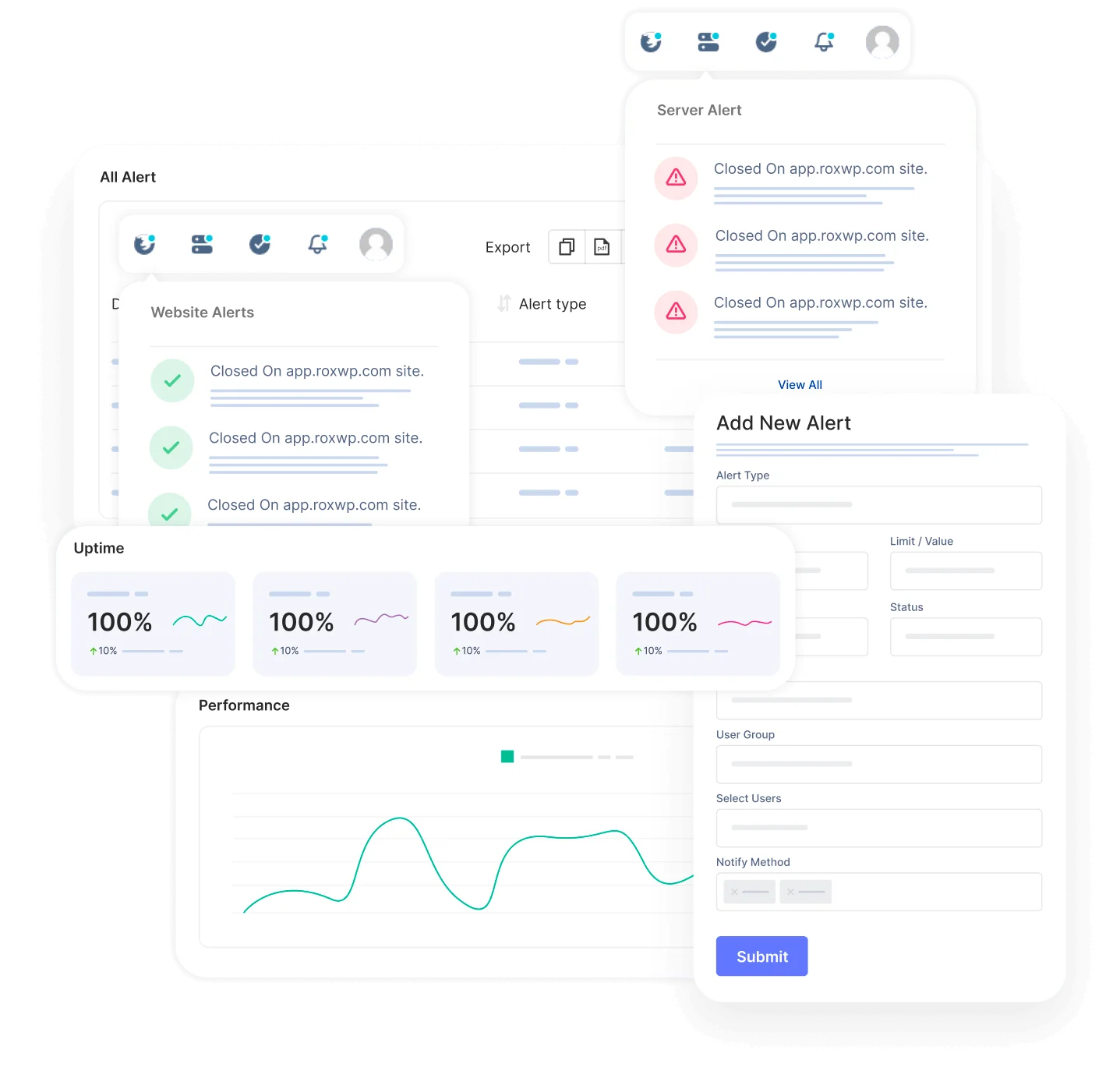
Key Features
- Reliable Website and Server Monitoring
- Network Performance Monitoring
- Check Monitoring Types
- Status Page Customization
- Alert Notifications
- Incident Escalation Policies
- Incident Timeline
- SSL Expiration Monitoring
- Search String Monitoring
- Monitoring for HTTP(s), Ping, Port, DNS, SSL & TLD expiration, Cron jobs
- Unlimited email and push notification alerts
- Capture screenshots & error logs for incidents
Pros
- Reliable Uptime Monitoring
- Easy Setup and Configuration:
- Cost-Efficiency
- Customer Support:
- Accurate Reporting:
- User-Friendly Interface
- Customizable Alerts
- Status Page
- Escalation policies
- Incident Timeline Report
Cons
According to user reviews, UptimeMonster doesn’t exhibit any notable drawbacks. However, a few users have highlighted certain feature limitations present in the free plan offering. These limitations might include restricted access to certain functionalities or reduced capabilities compared to the premium plans. Despite this, the overall consensus from users is overwhelmingly positive regarding the platform’s performance and functionality.
Our perspective on this matter revolves around the notion that smaller teams might not necessitate the utilization of numerous advanced features. Therefore, it appears reasonable to curtail access to certain functionalities, considering that smaller teams might not require or fully utilize these advanced features. This approach ensures a streamlined and more focused user experience, optimizing the platform’s usability for smaller teams with specific needs.
Pricing
- Standard plan at $7/month with 30 monitors and 2-minute interval
- Professional plan at $19/month with 50 monitors and 1-minute interval
- Business plan at $99/month with 100 monitors and 25-second interval
Elastic Stack
Elastic Stack, formerly known as ELK Stack, is a powerful collection of open-source tools designed for searching, analyzing, and visualizing large volumes of data in real time. Comprised of several components, each with its unique functionality, Elastic Stack provides a comprehensive solution for various data management and analysis tasks.
At the core of Elastic Stack is Elasticsearch, a distributed search and analytics engine. It stores and indexes data in near real-time, enabling fast and efficient searching across massive datasets. Elasticsearch is highly scalable, fault-tolerant, and supports complex querying capabilities.
Logstash is a versatile data processing pipeline that ingests, transforms, and enriches data from multiple sources before indexing it into Elasticsearch. It supports a wide range of input sources, including logs, metrics, and event streams, and offers extensive filtering and parsing capabilities.
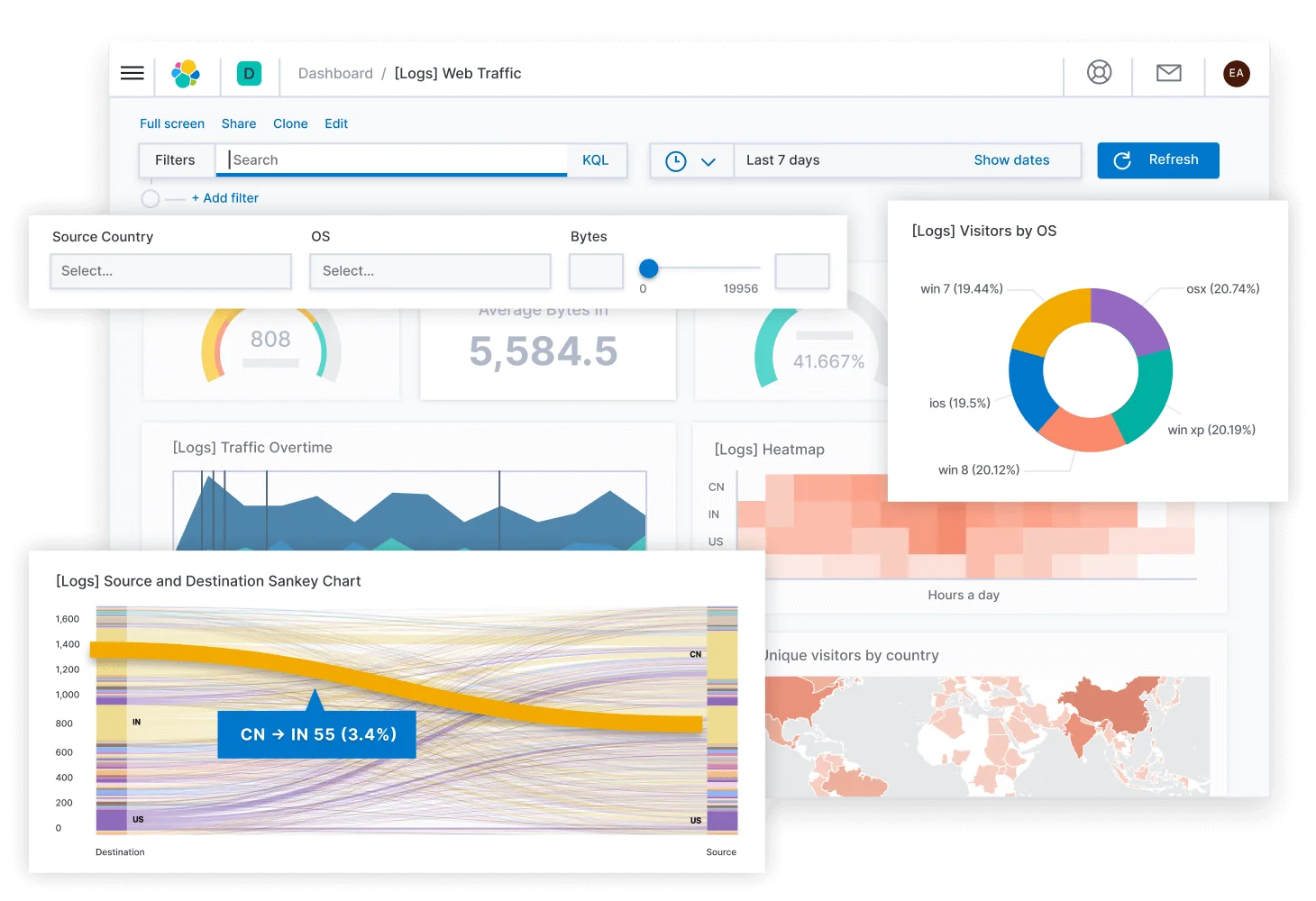
Key Features
- Open-source and cost-effective: The core functionality is free to use, making it budget-friendly for various needs.
- Scalable and flexible: Adapts to accommodate growing data volumes and diverse use cases.
- Real-time insights: Gain instant visibility into your data, enabling proactive decision-making.
- Powerful search and analysis: Explore and analyze data with precision using Elasticsearch’s robust capabilities.
- Stunning visualizations: Kibana empowers you to create impactful dashboards and reports for clear communication.
- Active community and support: Benefit from a vibrant community offering resources and assistance.
Pros
- Scalability
- Real-Time Data Processing
- Versatility
- Open-Source
- Comprehensive Toolset
Cons
- Complexity
- Resource Intensive
- Learning Curve
- Maintenance Overhead
- Documentation Gaps
- Licensing Considerations
Pricing
- Standard package starts at $95/month
- Gold package starts at $109/month
- Platinum package starts at $125/month
- Enterprise package starts at $175/month
Graylog
Graylog is an open-source log management platform that enables organizations to centralize, search, and analyze log data from various sources. It provides powerful tools for monitoring, troubleshooting, and securing IT environments by offering comprehensive log aggregation, analysis, and visualization capabilities.
Graylog provides a log management system built on Elasticsearch and MongoDB. This solution enables users to gather and centralize logs from their infrastructure, explore them, track errors, identify threats, and analyze data in a clear and accessible manner.
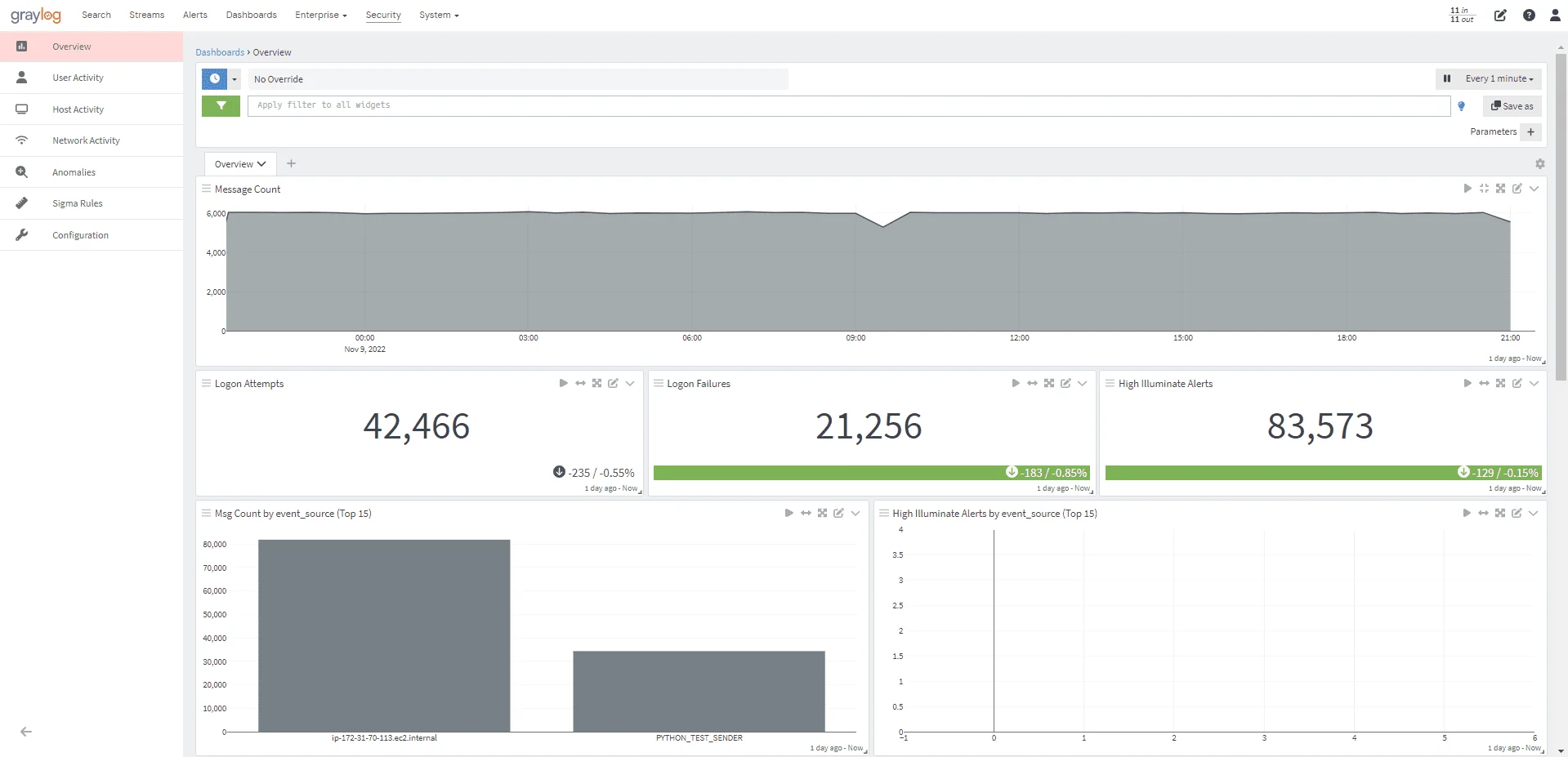
Key Features
- Log Collection and Centralization
- Search and Analysis
- Stream Processing and Pipelines
- Alerting and Notifications
- Dashboards and Visualizations
- Security and Compliance
Pros
- Open Source
- Flexibility and Extensibility
- Community Support
- Ease of Use
Cons
- Running Graylog effectively may require sufficient hardware resources, especially for handling large volumes of log data and real-time processing.
- While Graylog is user-friendly, mastering its advanced features such as stream processing and pipeline rules may require some learning and experience.
- Some advanced features such as role-based access control (RBAC) and alerting may only be available in Graylog Enterprise, which requires a paid subscription.
Pricing
- Garylog Operations Starting at $1250/mo* 10GB per day
- Garylog Security Starting at $1550/mo* 10GB per da
- Garylog API Starting at $1250/mo* 10GB per day
LogDNA
LogDNA is a cloud-based log management and analysis platform designed to streamline the process of logging and monitoring system and application logs. It provides users with a centralized location to collect, search, and analyze logs from various sources, including servers, containers, applications, and cloud platforms.
The comprehensive web application of LogDNA offers a suite of features including live tail, queries, visualization, and alerting through an intuitive interface. Users have the flexibility to filter data by fields, group them by source, and create customized views, graphs, and dashboards.
LogDNA’s pricing structure consists of three primary tiers: Community (free), Professional, and Enterprise, each offering different features and limits. Additionally, Mezmo employs a pay-as-you-go pricing model, ensuring users only pay for the resources they utilize.
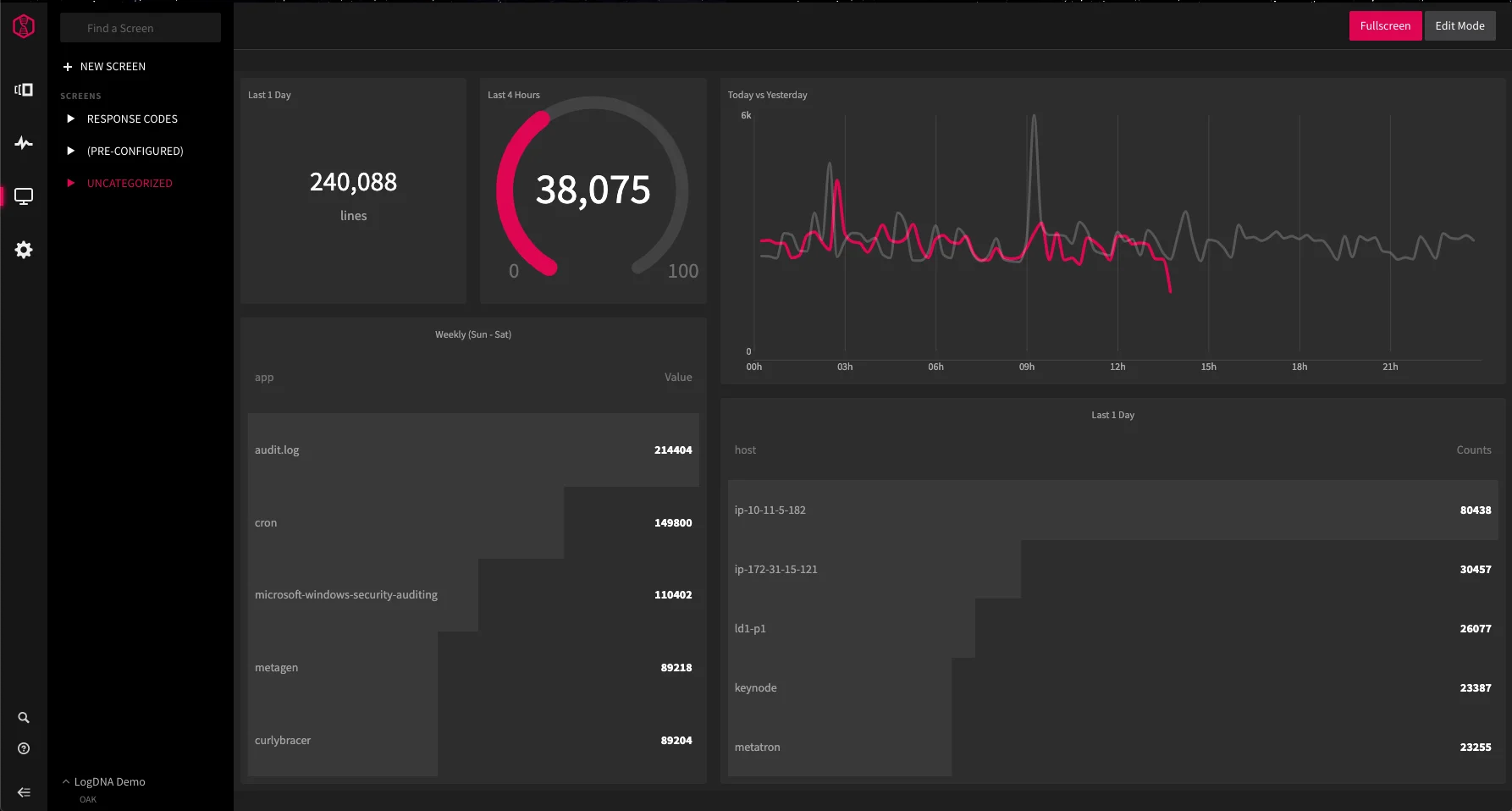
Key Features
- LogDNA allows users to aggregate logs from multiple sources into a single, centralized platform, making it easier to manage and analyze logs from different environments.
- It offers real-time log streaming capabilities, enabling users to view and analyze logs as they are generated, facilitating faster troubleshooting and problem resolution.
- LogDNA provides advanced search and filtering functionalities, allowing users to quickly search through large volumes of logs and filter results based on various criteria such as time, severity, and keywords.
- Users can create custom dashboards to visualize log data and track key metrics, providing insights into system performance and application behavior.
- LogDNA offers alerting and notification features, allowing users to set up alerts based on predefined criteria and receive notifications via email, Slack, or other channels when certain events occur.
Pros
- Ease of Use
- Real-Time Monitoring
- Scalability
- Customization
- Integration
Cons
- While LogDNA offers various pricing plans to accommodate different user needs, the cost may become a concern for organizations with large log volumes or extensive logging requirements.
- Some users have reported limitations in log retention periods, particularly in the lower-tier pricing plans, which may pose challenges for long-term log analysis and compliance purposes.
- While the platform is generally user-friendly, some users may encounter a learning curve, especially when configuring advanced features or customizing dashboards and alerts.
- Depending on the log volume and frequency of log ingestion, LogDNA may consume significant resources, potentially impacting system performance and scalability in resource-constrained environments.
Logz.io
Logz.io is a cloud-native observability platform that specializes in log management, monitoring, and security analytics. It is designed to help organizations collect, analyze, and visualize large volumes of log data from various sources across their infrastructure, applications, and cloud environments.
Its objective is to offer comprehensive monitoring and observability by consolidating logs, metrics, traces, and security events into a single platform. Moreover, it simplifies the utilization of the Elastic Stack, eliminating the need for intricate setup processes. Additionally, it offers various log shipping options, including SDKs, daemons, and cloud integrations, ensuring seamless integration into your application.
Key Features
- Centralize and analyze logs from diverse sources, including applications, servers, and containers, with powerful filtering and search capabilities.
- Gather and visualize real-time metrics from various sources for performance monitoring and troubleshooting.
- Gain end-to-end visibility into application requests across microservices, pinpointing performance bottlenecks and errors.
- Detect and investigate security threats across your IT environment with SIEM (Security Information and Event Management) capabilities.
- Leverages popular open-source technologies like Elasticsearch, Prometheus, and Jaeger, offering familiarity and flexibility.
- Scalability and Performance: Adapts to handle your growing data volume and ensures smooth performance.
Pros
- Unified Platform
- Open source benefits
- Scalability and performance
- User-friendly interface
- Customization
Cons
- Learning curve
- Limited free plan
- Resource requirements
Pricing
- Log Management starts at $0.92 Per ingested GB, per day
- Infrastructure Monitoring $0.40 Per 1000 time series metrics How does this work? per day 18 months retention
- Distributed Tracing $5 Per 1 million spans, per month 10 days retention
SigNoz
Signoz.io is a cutting-edge observability platform designed to provide comprehensive monitoring and troubleshooting capabilities for modern cloud-native applications. The platform offers a suite of features including log aggregation, metric collection, tracking, and alerting capabilities. It consolidates metrics, traces, and logs within an integrated user interface, facilitating seamless visualization and rapid issue resolution.
With native support for OpenTelemetry, it efficiently generates and manages telemetry data, enhancing observability across the system. Developed with a focus on developers, it leverages cutting-edge technologies like Go, Typescript, and React.js to ensure a modern and user-friendly experience.
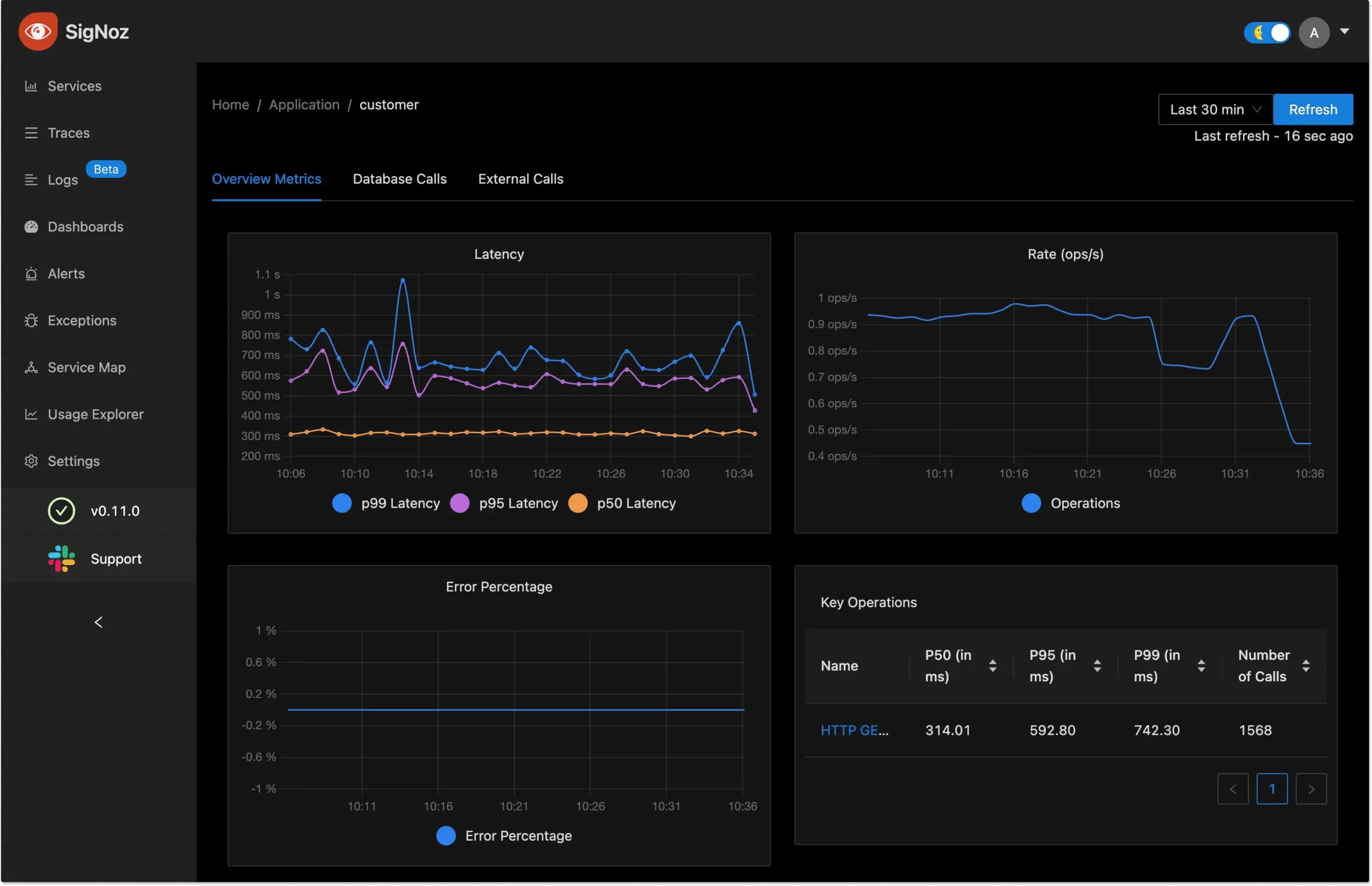
Key Features
- Distributed Tracing
- Metrics Monitoring
- Alerting and Notification
- Root Cause Analysis
- Integration with DevOps Tools
- Scalability and Flexibility
Pros
- Signoz.io provides comprehensive observability capabilities, including distributed tracing, metrics monitoring, and alerting, enabling users to gain deep insights into their application’s performance and behavior.
- The platform offers a user-friendly interface and intuitive navigation, making it easy for users to set up monitoring and troubleshoot issues without extensive training or expertise.
- Signoz.io allows users to customize dashboards, alerts, and monitoring configurations to suit their specific requirements, providing a tailored observability experience.
- Signoz.io is built on open-source technologies, making it accessible to a wide range of users and enabling contributions from the community to enhance its capabilities and features.
Cons
- The free plan has restricted features and data storage.
- Mastering advanced features might require some technical expertise.
- Not as established as some larger observability platforms, leading to a smaller community of support
- Integrating Signoz.io with existing infrastructure and applications may require some effort, especially in complex, distributed environments with diverse technology stacks.
Pricing
SigNoz.io offers a free plan for basic monitoring and paid plans with various features and data storage limits.
Fluentd
Fluentd is an open-source data collector that enables the unified logging layer across various systems. It acts as a middleware between data sources and data destinations, facilitating the collection, transformation, and transportation of logs and other data in real-time. Fluentd provides a scalable and flexible solution for log management, allowing users to centralize and analyze data from diverse sources efficiently.
Its customizability, scalability, and active community make it a compelling choice for businesses seeking control over their data pipelines. However, the learning curve and lack of built-in visualization require consideration before implementation.
Key Features
- Collects data from various sources like applications, servers, networks, and cloud platforms through plugins for diverse formats.
- Route collected data to different destinations based on filters and rules, enabling centralized log management and analysis.
- Handles large data volumes efficiently and adapts to your growing needs.
- Benefits from a vibrant community that contributes to plugins, documentation, and support.
- An extensive plugin library supports diverse data sources and destinations for maximum flexibility.
- Uses minimal resources compared to some heavier-duty platforms.
Pros
- Open-source and free
- Highly customizable
- Active community
- Lightweight and efficient
Cons
- Setting up and configuring Fluentd effectively requires some technical understanding.
- Troubleshooting issues might require manual investigation due to their customizable nature.
- Lacks built-in visualization capabilities, requiring integration with other tools for data analysis
- Running Fluentd instances can consume significant system resources, especially in environments with high log volumes or complex data processing requirements. Proper resource allocation and optimization are essential to ensure optimal performance.
- Maintenance Overhead: Managing and maintaining Fluentd deployments, including plugin updates, configuration changes, and performance tuning, can require ongoing effort and expertise, particularly in large-scale or dynamic environments.
Pricing
As an open-source project, Fluentd itself is free to use. However, additional costs might arise from:
- Cloud-based managed services: Some providers offer managed Fluentd deployments for ease of use at a subscription fee.
- Commercial plugins: Some specialized plugins from third-party developers might have associated costs.
Loggly
Loggly serves as a cloud-native log analysis management solution, offering comprehensive observability across the entire stack. It enables users to consolidate and analyze logs from diverse sources, even amidst vast data volumes. Loggly provides a centralized platform for collecting logs from various sources, including servers, applications, containers, and cloud services, making it easier to manage and analyze log data.
Users can monitor log data in real-time, enabling them to quickly detect and respond to issues as they occur, thereby minimizing downtime and improving system reliability.
Key Features
- Centralized Log Management
- Real-Time Monitoring
- Advanced Search and Filtering
- Visualizations and Dashboards
- Alerting and Notification
- Integration with DevOps Tools
Pros
- Loggly is known for its user-friendly interface and intuitive navigation, making it easy for users to get started with log management and analysis without extensive training or expertise.
- Loggly is designed to scale with the growing log volume and infrastructure complexity, ensuring that users can effectively manage logs across large-scale deployments without compromising performance.
- Its real-time monitoring capabilities provide instant visibility into system and application logs, enabling users to quickly identify and address issues before they impact operations.
- Loggly offers seamless integration with a wide range of DevOps tools and platforms, allowing for streamlined workflows and collaboration among development and operations teams.
Cons
- While Loggly offers various pricing plans to accommodate different user needs, the cost may become prohibitive for organizations with large log volumes or extensive logging requirements.
- Some users have reported limitations in terms of customization options for dashboards and visualizations, which may restrict their ability to tailor the platform to their specific requirements.
- In some cases, users have experienced issues with search performance, particularly when dealing with large volumes of log data or complex search queries, leading to delays in retrieving relevant information.
Pricing
- Standard package starting at $79 per month
- Pro package starting at $159 per month
- Enterprise package starting at $279 per month
DataDog
Datadog’s website monitoring stands out as a comprehensive solution that offers unparalleled visibility. It goes beyond mere aggregation by seamlessly collecting metrics and events from an extensive range of over 500 integrated technologies, tagging and storing them for further analysis.
Notably, Datadog streamlines the entire process by taking care of the ingestion, normalization, and enrichment of logs, allowing users to focus on deriving meaningful insights rather than grappling with technical intricacies. This ensures a user-friendly experience and maximizes the efficiency of log management operations.
Furthermore, Datadog doesn’t stop at threat identification; it actively tracks the performance impact of every deployed code. This automated tracking extends to mapping data flows and dependencies through a service map, offering a visual representation of the intricate relationships within the infrastructure. By doing so, Datadog not only ensures robust security but also provides valuable insights into the operational dynamics of the entire system.
Pros
- Real-time log tracking
- Security monitoring
- Integrations
- Alerting system
- Custom downtime for deployment
Cons
- The primary weakness of Datadog lies in its scaling capabilities. Increasing metrics monitoring necessitates additional monitors, significantly impacting monthly billing and leading to high expenses.
- Datadog’s complexity might pose challenges, particularly for users unfamiliar with monitoring systems. Navigating and finding specific functionalities can be challenging without prior experience.
- Immediate action is lacking when decommissioning a host. It takes up to 24 hours for a host to be officially removed from the list, causing delays in real-time updates upon decommissioning.
- The basic plugins in Datadog offer limited information. Users often need to configure their plugins to obtain more detailed reports, adding complexity to data retrieval.
- Graphical reports in Datadog are not intuitively comprehensive, failing to provide easily understandable and valuable information to users.
Pricing
- Pro package at $15 per host/per month
- Enterprise package at $23 per host/per month
Nagios
Nagios is an open-source and commercial monitoring tool used by businesses of all sizes to keep their IT infrastructure up and running. It monitors everything from servers and networks to applications and services, alerting you to potential problems before they become critical.
Nagios XI diligently monitors various elements of your infrastructure, encompassing applications, operating systems, network architecture, network protocols, services, and system metrics. Its extensive library of hundreds of third-party add-ons empowers you to monitor virtually any internal or external program, service, or system with flexibility and adaptability.
Nagios Fusion unites dispersed Nagios XI and Core servers, granting panoramic network oversight and simplifying issue resolution across vast networks. Centralize diverse Nagios deployments with Fusion, boosting scalability and resolving geographically scattered network issues effortlessly.
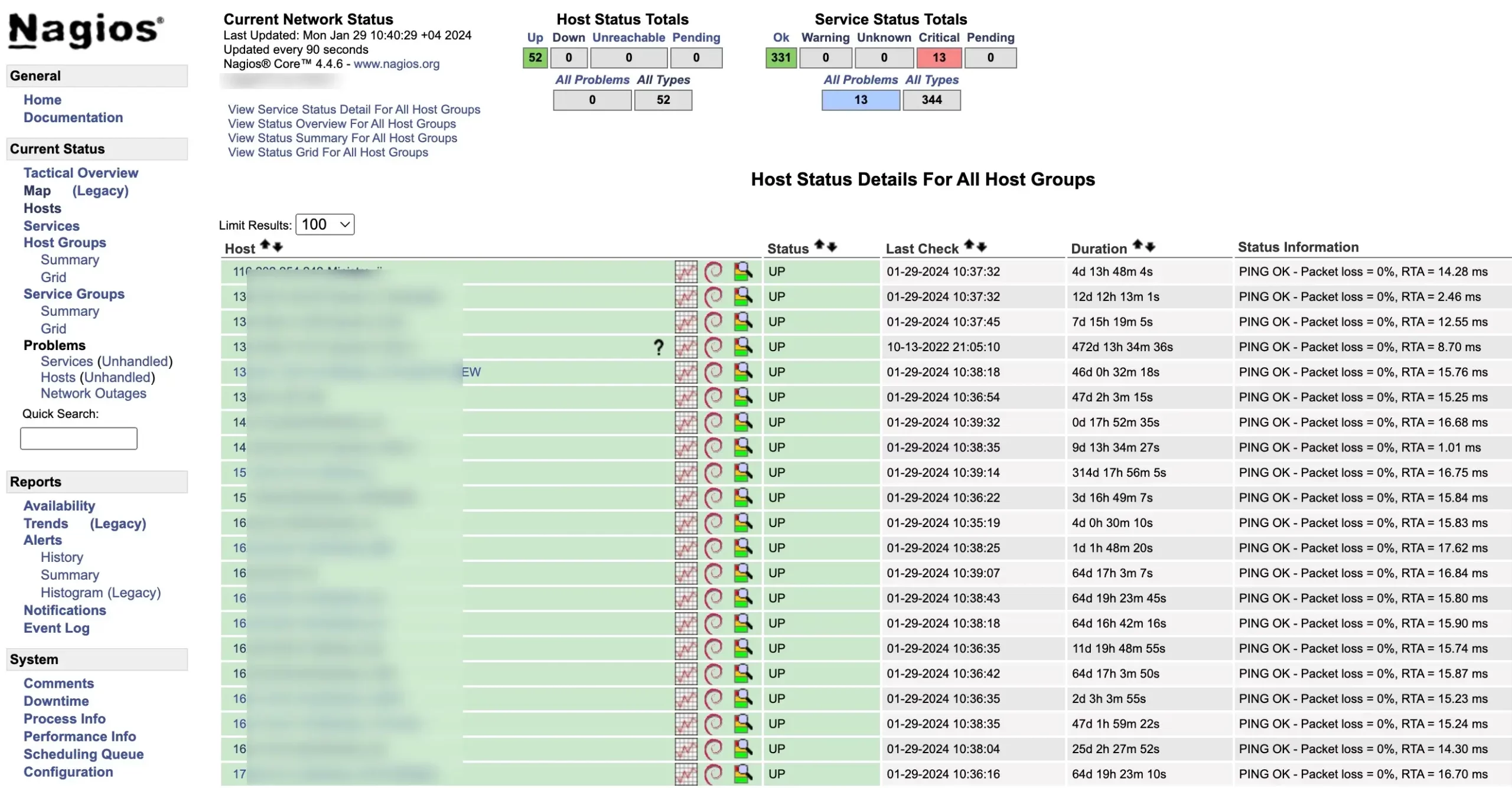
Key Features:
- Monitoring of various IT components: Nagios can monitor servers, networks, applications, services, and more. It supports various protocols like SNMP, Ping, SSH, and WMI to collect data from different devices and systems.
- Customizable alerts and notifications: You can define custom alerts and notifications for different types of issues. Nagios can send alerts via email, SMS, instant messaging, or other channels to ensure the right people are notified promptly.
- Reporting and data analysis: Nagios provides comprehensive reports and data analysis to help you track trends, identify potential issues, and improve the performance of your IT infrastructure.
- Flexible and scalable: Nagios is highly flexible and scalable. You can start with a basic setup and add more features and functionality as your needs grow.
- Open-source and commercial options: Nagios Core is an open-source solution, while Nagios XI is a commercial version with additional features and enterprise-grade support.
Pros
- Highly customizable: Nagios can be customized to meet the specific needs of your IT infrastructure.
- Wide range of features: Nagios offers a wide range of features for monitoring different aspects of your IT environment.
- Powerful alerting system: Nagios’ alerting system ensures that you are notified of potential problems promptly.
- Active community: Nagios has a large and active community that provides support and helps you troubleshoot any issues.
- Cost-effective: Nagios Core is free to use, and Nagios XI is relatively affordable compared to other monitoring solutions
- Integration Capabilities: Nagios seamlessly integrates with various third-party tools and services, fostering compatibility and expanding its functionality according to organizational needs.
Cons
- Can be complex to set up: Nagios can be complex to set up for beginners, especially the open-source version.
- Requires technical expertise: Using and maintaining Nagios effectively requires some technical expertise.
- Limited scalability for large enterprises: The open-source version of Nagios may not be scalable enough for large enterprises.
Pricing
- The initial cost for Nagios XI begins at $1,995 per instance, billed on an annual basis.
Paessler PRTG Network Monitoring
PRTG network monitoring solution is designed to track network up/down status, traffic, and usage. Key features encompass availability, performance, and bandwidth monitoring through SNMP, WMI, packet sniffing, and NetFlow. Instant alerts, comprehensive reporting, and failover clustering are included.
PRTG Network Monitor operates as an agentless solution, eliminating the need for agent installations on target devices and applications. Instead, it utilizes network protocols like SNMP, WMI, NetFlow, or SSH for efficient and swift monitoring. This approach reduces the burden and ensures a seamless monitoring experience.
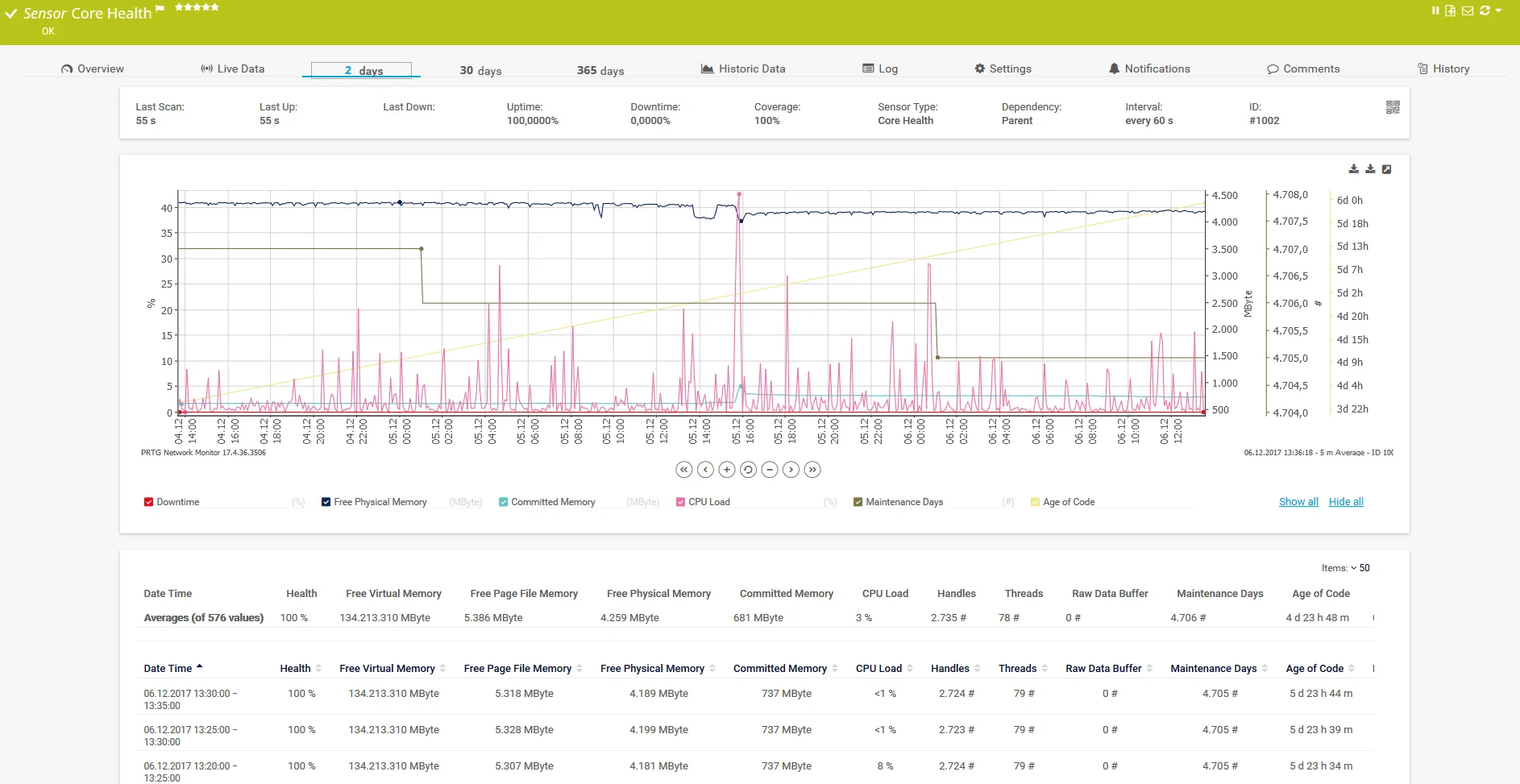
Key Features
- In-depth Reporting
- Maps and Dashboards
- Flexible Alerting
- Distributed Monitoring
- Cluster Failover Solution
- Multiple User Interfaces
Pros
- Agentless Monitoring
- Varied Network Protocols
- Customizable package
- Traffic management and comprehensive monitoring of network devices.
- Enables full-stack monitoring for a holistic view of the system.
Cons
- No patch manager
- Limited historical data in the free version
- It’s Windows base especially so managing too many Linux machines causes issues
- Licensing can be tricky as it is not based on devices but rather on sensors. Currently, each sensor, such as an interface, is counted as a sensor license.
- Maps are difficult to make
Netdata
Netdata collects metrics every second and displays them in visually appealing, low-latency dashboards. It is crafted to operate seamlessly across your physical and virtual servers, cloud setups, Kubernetes clusters, as well as edge/IoT devices. This allows comprehensive monitoring of your systems, containers, and applications.
Its design incorporates infinite scalability, offering a flexible and highly modular solution. With a user-friendly interface, it is immediately available for troubleshooting without the need for prior knowledge or preparation. Moreover, Netdata seamlessly integrates into existing monitoring toolchains, supporting compatibility with popular solutions like Prometheus, Grafana, Graphite, OpenTSDB, InfluxDB, and others.
Key Features
- Website Monitoring
- No Coding Required
- Real-time Collaboration
- Lightweight
- No Registration Required
- Dark Mode
- Works Offline
- No Tracking
Pros
- Real-time insights
- Easy to use
- Customizable
- Open-source
- Lightweight and resource-efficient
- Active community
Cons
- Setup/configuration is very hard for the beginner
- limited reporting/analytics functionalities
- The UI may seem complex for some users.
- Custom alert configuration is complicated
- Expensive
Pricing
- The business package is $3 per/Node
Site24x7
Site24x7 is a comprehensive website monitoring solution designed to ensure the optimal performance and availability of websites, servers, applications, and networks. The platform delivers automated network discovery and inventory management, coupled with the automatic generation of a network topology map.
It extends its monitoring capabilities across multiple sites and internet connections, including tracking the performance of web applications and websites.
Encompassing all IT assets, the Site24x7 system ensures complete stack observability. This facilitates instant root cause analysis in the event of any issues. For instance, if there’s a slowdown in application delivery, immediate insights will reveal whether it’s a network-related problem. Notifications about network device issues are promptly relayed, aiding proactive issue resolution.
Key Features
- Website Monitoring
- Server Monitoring
- Synthetic Web Transaction Monitoring
- Application Performance Monitoring
- Network Monitoring
- Public and Private Cloud Monitoring
- Real User Monitoring | RUM
- Cloud Cost Management
- Public Status Pages
- RMM for MSPs and CSPs
- Log Management from the Cloud
Pros
- Monitor Web applications and websites effectively.
- Track the performance of systems hosted both on-premises and in the cloud
- Full stack observability ensures immediate identification of root causes
- Ease of Use
- Integration Capabilities
Cons
- The setup of the Realtime user monitor was not as functional as expected about adding 3rd party scripts.
- Takes a long time to set up everything for monitoring
- Occasional False Positives
- Costly
Pricing
- Pro plan at $35 with 40 monitors
- Classic plan at $89 with 100 monitors
Wrapping Up
Choosing the best Splunk alternatives requires a thorough assessment of your unique requirements and how well they match the features provided by different monitoring solutions.
After conducting thorough research and rigorous testing, UptimeMonster has proven itself as the premier substitute for Splunk. It encompasses all the vital features essential for smooth project management, presenting a cost-effective solution that is especially advantageous for startups and small teams.
